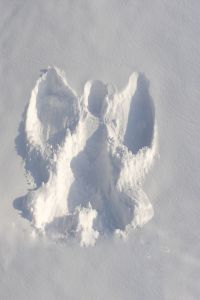When trying to support children who have language challenges, how can you possibly address grammar, sentence structure, verb tenses, pronouns, concepts, comprehension, and other skills all at once – while teaching an entire class? A good place to start is to integrate PRE-TELLING; TELLING, and RE-TELLING (PTR) into your activities. PTR provides children with routine and repetition, which are both boosters for language development.
PTR can happen throughout the day to explain activities that will happen over a long or immediate time frame. It can help children understand what is expected of them. Likewise, it gives children a strong, predictable model for learning to describe their plans and experiences. PTR is most effective when paired with visual prompts. These might include a picture schedule, a demonstration, or use of gestures.
This article gives an example of using PTR for making a snow angel and other activities. It also provides samples of charts for enriching early literacy and language. Just for fun, I will explain the concept of PTR using the adventure for making snow (sand) angels. I will also incorporate the sequencing words: First, then/next, and last to promote narrative and comprehension skills.
Snow Angel and PTR

Background information: In this instance, the children have been exploring snow with all of their senses. In addition, they are learning to create visual graphs to complete class surveys and to chart facts. Today, they are going to chart what they learn about snow by using their senses. Nothing better than jumping into the experience – they are going to make snow angels! Snow angels are made by lying in the snow and sliding your arms and legs up and down. The resulting design is thought to resemble an angel.
Watch what happens to the verb “wave” as each step occurs below:
Pre Telling – Do this BEFORE you start the activity
- FIRST, we will lie down on the snow.
- NEXT, we will wave our arms and legs across the ground. (Demonstrate)
- LAST, we will stand up.
Tell – Do this DURING the task
- FIRST, we are lying down on the snow.
- NEXT, we are waving our arms and legs across the ground.
- LAST, we are standing up!
Retell – Do this AFTER you are done
- FIRST, we lay down on the snow.
- NEXT we waved our arms and legs across the snow.
- LAST, we stood up!
Bonus: Have the children draw their angel-making “story” and retell it to you! What happened first, next, and last? Now you are addressing literacy, too!
Keep in mind that you can adjust the length and complexity of your statements, based on the needs of your class. You might only talk about two steps, such as “First, we will wash our hands. Then, we will eat”. This is a first-then statement. As a parent, I use first-then all the time as in, “First, finish your homework! Then you can play.” To further help the children who do not retain information, give the directions again one step at a time as relevant to the task. Be sure the child understands the vocabulary in your direction.
While you are enriching literacy and exploring snow, get into the spirit with the following poem. Use gestures and body movements. The poem is predictable and it includes rhyming.
Crunch crunch crunch Across the snow we go!
Crunch crunch crunch Squash it with our toes!
Crunch crunch crunch I have a frosty nose!
Crunch crunch crunch I love the sound of snow!
This visual chart helps children to expand and categorize their vocabulary. The children filled in the words after experiencing snow. One use is to write in ideas with one color of marker before you experience the snow activity. After, revisit each category to add or modify words.
| SNOW | |
| See | FLUFFY SNOWFLAKESWHITE COVERS THE GROUND |
| Hear | CRUNCHES WHEN WE WALK ON ITQUIET |
Smell | LIKE AIRLIKE ICE |
| Taste | LIKE ICELIKE A SLUSHY WITH NO FLAVOR |
Feel | COLDWET WHEN IT WARMS UPLIKE ICECREAM |
Ideas | SNOW ANGELSSNOWBALLSSNOWMEN |
STICKS TOGETHER
SNOWFORTS
MAPLE SYRUP AND SNOW
SLEIGH RIDES
Table 1
Other Used for PTR:
Long Range Time Frame or Schedule: Explaining the key tasks before recess (i.e. art, music, math)
- What will happen first, next, and last?
- What is happening first, next, and last?
- What happened first, next, and last?
Partial Use of PRT: Expectations for going to a school assembly
- What will happen first, next, last? (First, we will walk to the gym. Next, we will sit in our spots and keep quiet. Last, we will walk back to class and sit down in our desks.)
- What happened first, next, last? (First, you walked to the gym. Next, you sat in your spots and kept quiet. Last you walked back to class and sat down in your desks. Way to go!)
Immediate Use of PRT: Directions for Participating in a Class Routine
- What will happen first, next, and last? (First, we will wash our hands. Next, we will eat our lunch. Last, we will put on our coat and sit down.
- What is happening first, next, and last? (First, we are washing our hands….Next, we are eating…..Last, we are putting on our coats.)
- What happened first, next, and last? (First, we washed our hands. Next, we ate our lunch. Last we put on our coats. Good listening! Let’s go outside!)
Intermittent Use of PTR: Reading a Story to the Class
- What will happen first, next, and last? (First, Goldilocks will go into bears’ home. Next, she will eat their food. Next, she will break their chair. Last, the bears will find her asleep – I wonder where she will be sleeping?)
- What is happening? (First, Goldilocks is going into the bears’ home. I wonder what she will do next?…)
- What happened first, next, and last? (First, Goldilocks went into the bears’ home. Next, she….) Use the pictures as prompts and encourage the kids to finish your sentences.
Prompted Use of PTR: Helping students to share ideas and experiences in an organized manner
- Child: I had my birthday party yesterday
- Adult: You had your birthday party!? Super! What did you do first? What happened next? Then what? What did you do last?
As needed, provide the sentence starter for the child, such as by saying First, … Next…, Last….
To further boost the language, ask what her favourite part was. Ask about a part she would do differently. Ask her to describe one of her presents. Encourage her to retell her experience by drawing a picture beside each step below. This table could also be used as a wish box for what the students want or plan to happen. Later, they could draw what really happened and compare the two. It could be a two step story, such as First we did this – then we did that. Or it could be lengthened by adding the words next or then.
| My Party | |
| First | |
| Next | |
| Then | |
| Last | |
Table 2
Other considerations:
- Set up an adventure about what is going to be interesting or important about this activity. This helps to engage the children, as it becomes relevant to them.
- Demonstrate or use gestures, props, or pictures to give the children more visual information.
- Enrich language by making statements like, “I wonder what …?
- Involve multiple senses. For instance, talk about what the snow might look/feel/taste/sound like. Then go out and experience it!
If a school district in your area needs Speech-Language Pathologists, please let me know by email as we at TinyEYE can help!
All the best to you,

![]()
Marnee Brick, MSc
Speech-Language Pathologist and Director of Speech Therapy
TinyEYE Therapy Services (Speech Therapy Telepractice)
Growing smiles, mending spirits, engaging children in their lives


